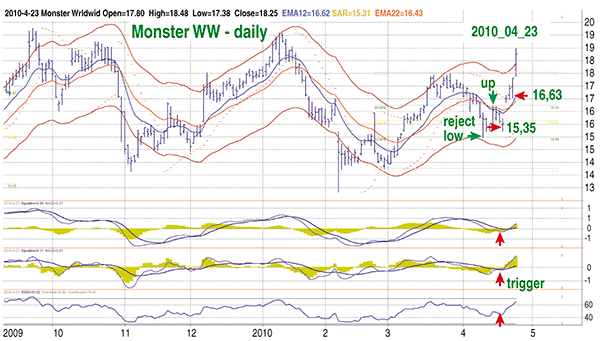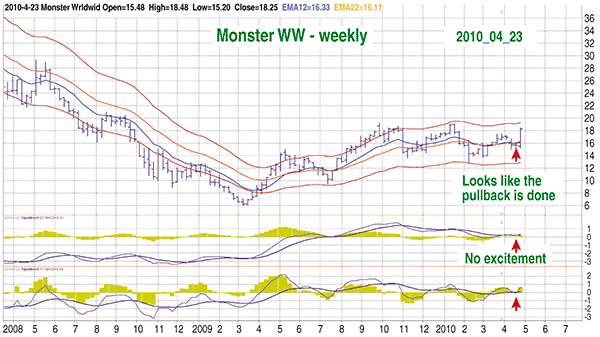
HOT TOPICS LIST
- Strategies
- Stocks
- Buy
- Investing
- Brokers
- Psychology
- Interviews
- Accumulate
- Sell
- Hold
- Spotlight
- Websites
- Candlestick Corner
- Gold & Metals
- Options Trading
LIST OF TOPICS
TRADER'S NOTEBOOK
Monster Profit, Monster Slip
05/26/10 10:27:49 AM PSTby Alexander Elder, MD
SpikeTrade is a group of 20 professional and semipro traders engaged in a weekly competition. Each member submits his or her pick on Sunday, along with the entry, target, and stop. The picks are submitted in private, and then all is revealed on Sunday afternoon. At the end of each week, the Spiker who wins that week’s competition writes up his or her analysis of the trade.
In this article I will review the winning trade from the week ended April 23, 2010. The trader is Peter D., one of our international Spikers. A Dutchman living in southern Europe, he is one of the longer-term members of the Spike group. You can see his profile and the description of his trading style on the SpikeTrade.com website. This win put him into a silver position on equity and bronze on points for the current quarter. Here is Peter’s review and analysis of this winning trade.— AE
| PETER D: MONSTER WORLDWIDE On the weekly chart (Figure 1), Monster Worldwide (MWW) is in a longer uptrend. Just before my entry (end of April 2010) it made a higher low slightly below its moving average. The previous week’s price bar was very small, suggesting bigger movements ahead. The weekly moving average convergence/divergence (MACD) supported that idea by tracing a higher bottom, which was very shallow.
FIGURE 1: MONSTER WORLDWIDE, WEEKLY. As you can see, the stock price has been in a long, gentle uptrend since March 2009. The price movements toward the end of April 2010 suggest large movements ahead. This is also supported by the action in the MACD.
On the daily chart (Figure 2), the decline stopped right at the 33% Fibonacci retracement level. The stock jumped on Wednesday, signaling upside potential. It settled lower on Thursday and Friday, giving the impression it was getting ready for another jump. The shallow MACD showed the absence of bears and flashed a buy signal, confirmed by the relative strength index (RSI). |
 FIGURE 2: MONSTER WORLDWIDE, DAILY. You can see that the pullback stopped right at the 33% Fibonacci retracement level. The price then jumped on Wednesday, signaling upside potential. It settled lower on Thursday and Friday, giving the impression that it was getting ready for another jump. A shallow MACD showed the absence of bears and flashed a buy signal. This was confirmed by the RSI. All conditions lean toward an entry in the following week.
Prices jumped on Tuesday and continued to rise on Wednesday. During Wednesday I considered exiting at this profit level but decided to adjust my stop to the Tuesday high instead, securing a maximum profit at that point. |
| I prefer to take profits on half of my position where originally planned - and let the rest run with a wider stop. I also like to split my entry in two, giving the first half a wide stop and trying to get a better entry on the second half. —Peter D. TRADE REVIEW Peter’s entry was very hard-edged. He saw a longer-term bottom being formed but expected weakness from the market’s bearish sentiment. He put in his entry order below the market, prepared to capitalize on the weakness or stand aside if that weakness failed to materialize. As a result, he bought near the low of the week. His exit, on the other hand, was a completely different story. Looking at the technical signs on the day of the exit, all we see is strength — prices are rising, confirmed by rising moving averages, MACD, and force index. Why sell? It seems to me that the only reason to sell is the fear of a profit slipping away. We’ve all been there — happy with a profitable trade, but afraid to lose our gain and exiting too soon. Why do we do it? Psychologists have shown that the fear of a loss is 2.5 times stronger than the desire for gain. This is why fear drives most traders more strongly than greed. The goal, of course, is to be neither fearful nor greedy, but realistic. Peter offers one possible solution — he splits his trade in two and handles one half a little tighter, the other a little looser. Do you have any questions or feedback on this trade? Please post your comments or questions on our Message Boards at SpikeTrade.com. |
| SUGGESTED READING Elder, Alexander [2010]. “Full Cuppa JOE,” Technical Analysis of STOCKS & COMMODITIES, Volume 28: July. _____ [2010]. “The Rubber Band Effect,” Technical Analysis of STOCKS & COMMODITIES, Volume 28: June. _____ [2010]. “Channel Trade Win,” Technical Analysis of STOCKS & COMMODITIES, Volume 28: May. _____ [2010]. “A Gem In The Junk Pile,” Technical Analysis of STOCKS & COMMODITIES, Volume 28: Bonus Issue. _____ [2010]. “How I Won My Gold,” Technical Analysis of STOCKS & COMMODITIES, Volume 28: January. _____ [2006]. Entries & Exits: Visits To 16 Trading Rooms, John Wiley & Sons. _____ [2002]. Come Into My Trading Room, John Wiley & Sons. |
Alexander Elder is a professional trader based in New York City. He is the author of Come Into My Trading Room (Barron’s 2002 Book of the Year) and Trading For A Living, considered modern classics among traders. He also wrote Entries & Exits and Sell and Sell Short. He runs SpikeTrade.com with Kerry Lovvorn, a professional trader from Alabama. He may be reached at info@spiketrade.com.
PRINT THIS ARTICLE

|

Request Information From Our Sponsors
- StockCharts.com, Inc.
- Candle Patterns
- Candlestick Charting Explained
- Intermarket Technical Analysis
- John Murphy on Chart Analysis
- John Murphy's Chart Pattern Recognition
- John Murphy's Market Message
- MurphyExplainsMarketAnalysis-Intermarket Analysis
- MurphyExplainsMarketAnalysis-Visual Analysis
- StockCharts.com
- Technical Analysis of the Financial Markets
- The Visual Investor
- VectorVest, Inc.
- Executive Premier Workshop
- One-Day Options Course
- OptionsPro
- Retirement Income Workshop
- Sure-Fire Trading Systems (VectorVest, Inc.)
- Trading as a Business Workshop
- VectorVest 7 EOD
- VectorVest 7 RealTime/IntraDay
- VectorVest AutoTester
- VectorVest Educational Services
- VectorVest OnLine
- VectorVest Options Analyzer
- VectorVest ProGraphics v6.0
- VectorVest ProTrader 7
- VectorVest RealTime Derby Tool
- VectorVest Simulator
- VectorVest Variator
- VectorVest Watchdog

